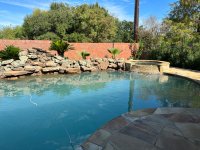Now, let's come back to the question of how important the CYA really is? Well, if you are in somewhere not so much sun, you can use less or forget about it all together! For instance, if I have an in-door pool, I don't need it, because it tight up my FC which force me to dump more bleach to kill the bacteria. So, CYA can be as little as 0 - 20. Well, if I am in Texas or California or Florida, I can use more of that stuff. Well, you can put 80 to 120 ppm. If you ask me if CYA is that critical, my answer would be: probably not! If I don't use it or use less ----- it probably means every day I dump more bleach into the water to compensate the UV loss of chlorine! That only means being a fool that I waste some money to it, that's all. You will figure out pretty soon go up a little with CYA will save you money!!!! That's all there is to it, my friends! The experts even don't agree from each other on how much CYA you really need, so don't put too much, because it eventually will lock up your chlorine that no matter how much BLEACH you pour into the pool, it still won't stop your algae boom, then you are in a big problem!!!! So using too much of it is really a bad thing from this point of view. Furthermore, the chlorine tablet has tons of that stuff mixed in, that's why a lot of people can easily get too much of it into their pool without knowing it. It's a pain on the Rear, because in order to get rid of it you have drain some water and replace some fresh water, which is something I really reluctant to do.









